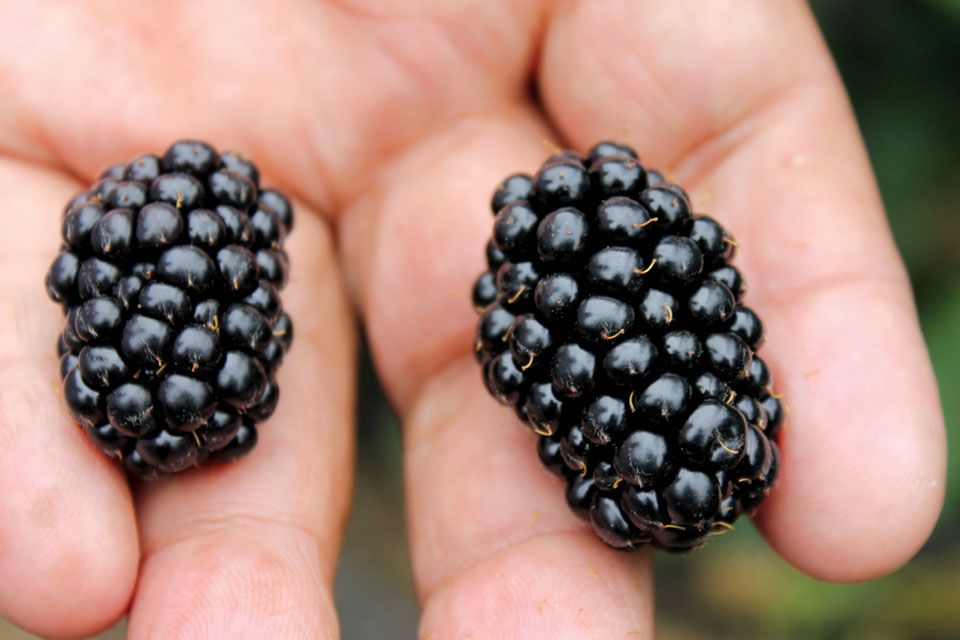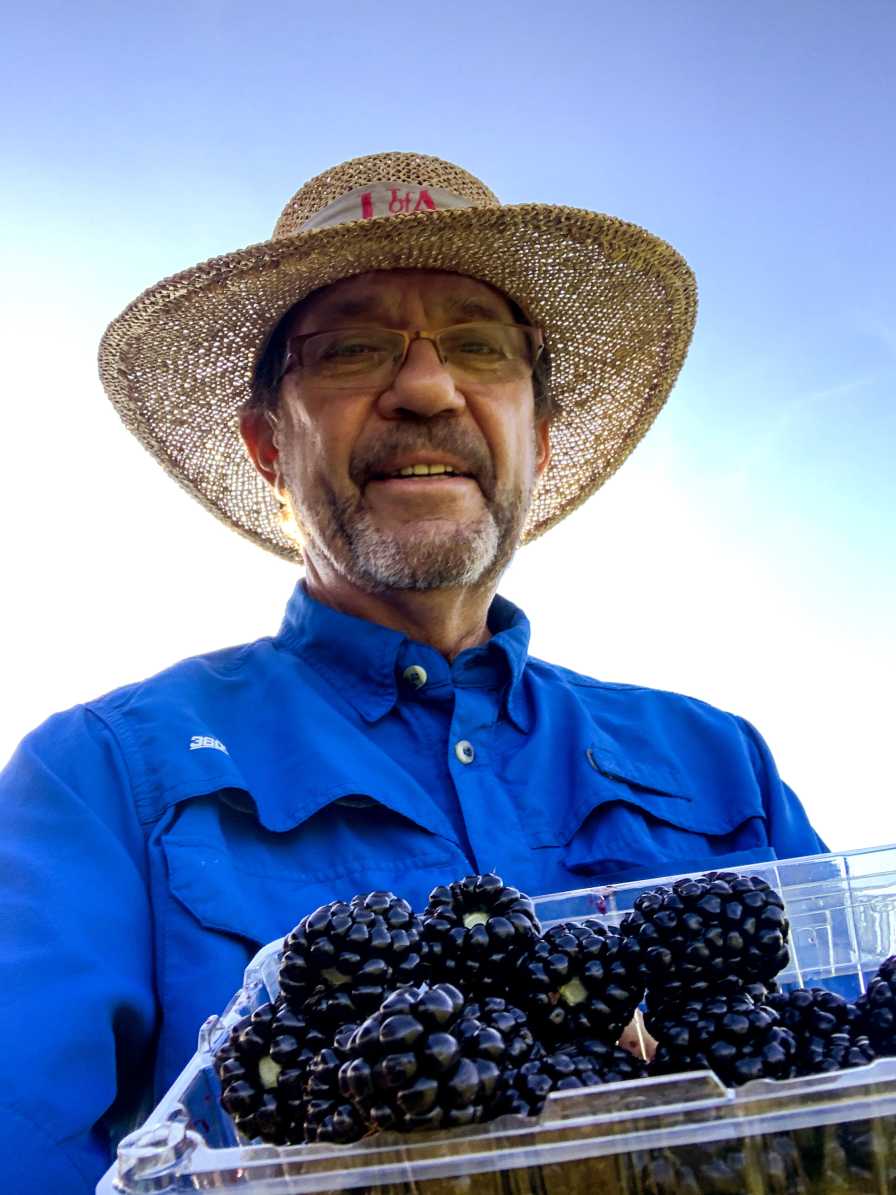Big Opportunity in Berries? Favor the Flavor

Berry flavor is a big deal. The latest blackberry varieties are much sweeter than those in the past.
Flavor. What brings a bigger smile to berry-buying customers? If good berry flavor is not experienced, customers might not be back for more. Flavor is a joy to experience but can be a little scary to deliver. Scary to whom? Growers, shippers, even berry breeders!
There is a LOT that goes into flavor, and I want to share some of my experiences and knowledge on the subject.
WHAT IS FLAVOR?
Overall, when I think of flavor in berries, I identify four major components: sweet, tart (sour), aromatics (flavor compounds often detected in the nasal and oral cavities), and bitterness. The levels of these vary in importance in different berries. For instance, the presence and number of aromatic compounds are quite different between a strawberry and blueberry.
My food science colleague and friend Dr. Luke Howard explains this best: “Flavor is composed of taste and aroma, but aroma plays a more important role. Pinch your nose and taste different berries and they all taste sweet and sour, and possibly bitter, but it is difficult to identify each one since you are not detecting the volatile compounds that give each berry a unique aroma.”
Sweetness, tartness, aromatics, and bitterness can vary due to a number of factors, and some additional flavor components can be present such as astringency, or off-flavors from decay or storage. I share below a few comments and experiences with the major components of flavor and what I think will be key in our expanding berry markets in the future.
SWEET AND TART
I put these two items first because I think they make the first and most pronounced initial flavor impression, as they are detected on the palate. If the berry is overwhelmingly tart, then often the remaining components of flavor don’t matter. In general, berry growers and those working to improve flavor (breeders, production management researchers, etc.) emphasize the improvement of sweetness.
I believe the most common consumer complaint about berries is a lack of sweetness, particularly with the berry I spend the greatest amount of time with— blackberries. I commonly tell folks that most people in the world have never had a sweet blackberry, and many think the way to eat blackberries is with contaminants like added sugar and ice cream. Consumers vary in how sweet they prefer berries.
Early in my career, I had a distinct experience in evaluating blueberry seedlings with two of the most accomplished berry breeders of our time, Dr. Arlen Draper and Dr. Jim Moore. We came upon one seedling that was very sweet, and I really liked it; they chastised me about it not having a good sweet/tart balance. What occurred that day was simply a flavor preference I had for a sweeter vs tart flavor. I have learned that people vary greatly in sweetness preferences, which have been noted in relation to age and cultural background.
Tart flavor at a high level is usually unpleasant to fresh berry consumers. In general, berries picked prematurely tend to be tart. This is common of berries in the marketplace, as growers are concerned about getting the berries to market in the best condition and appearance.
I remember about 40 years ago Dr. Moore, my mentor and predecessor at the University of Arkansas, telling me the story of conversing with a blackberry grower in Kansas about a certain variety that was known for vary tart berries. Jim asked the grower, “How do you eat those things?” The grower replied, “I don’t eat ‘em; I sell ‘em!” I think the days are nearing an end when berry producers will be able to stay in business with tart and marginally sweet berries; or by selling berries only for jelly, cobblers, pies, and ice cream toppings. Health-conscious consumers have too many other fresh fruit choices today.
AROMATICS
Some will say aromatics and other associated flavor compounds detected in our olfactory system — related to our sense of smell — are really what flavor is. I disagree to some extent since I consider sweet and tart to be the front-line sensations when eating berries. I tend to think that offensive tartness is rarely overcome with aromatic appeal. Aromatics really define the differences in our four major berries, as the profile of these compounds vary greatly among strawberries, blueberries, blackberries, and raspberries.
Overall, I think the attractive aromatic profile of berries has greatly improved in recent years due to advances in genetics, postharvest handling, and other factors. The expansion of the degree of aromatic expression in berries will drive success in berries in the future, and I would examine closely the aromatic profile potential when choosing a variety to plant.
One of the most significant, current changes in fruits is in table grapes. If you live in the Eastern U.S., there is a good chance you have tasted a “flavored” grape or grape product, with ‘Concord’ being the most common variety experienced. Its distinct flavor is due to an aromatic profile containing primarily methyl anthranilate. Have you had ‘Cotton Candy,’ ‘Candy Dreams,’ ‘Candy Snaps,’ or ‘Candy Hearts?’ These are examples of popular “niche” category varieties. They taste distinctly different than standard, neutral table grapes. Flavor is the difference in these, and they are getting world attention due to the unique flavors expanding greatly in the marketplace.
BITTERNESS
There is no need to say too much about bitterness in berries. If we were discussing beer, then we would have a lot more to talk about. In general, bitterness is undesirable in berries, although some might suggest bitterness contributes to other flavor components. I have found that individuals vary tremendously in their ability to detect bitterness.
When I have a group of visitors with me tasting blackberries, I usually try to determine who is most sensitive to bitterness. I then benefit from that person detecting bitterness to the slightest degree as we move among various selections and varieties. Fortunately, bitterness is not especially common in strawberries, blueberries, and raspberries, and can be bred out of blackberries quite easily.
I know that yield, berry size, postharvest handling capability, adaptation, and other major factors drive most variety decisions. I think flavor potential will be driving choices to a greater degree in the future. I will re-visit flavor and discuss some factors impacting flavor in a future column.










